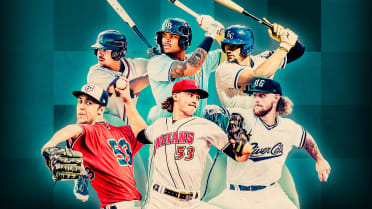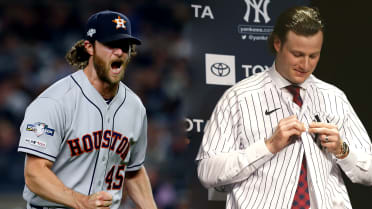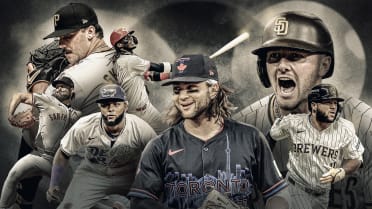Is Nationals' pitching strategy sustainable?
WASHINGTON -- The Nationals will go as far as the arms of their aces will carry them.
The Nats' strategy to win Game 2 of the National League Division Series showed they are willing to pull out all the stops in their attempt to upset the Dodgers, grabbing a game to send this NLDS back to Washington tied.
Max Scherzer and Stephen Strasburg have combined to throw 15 of the Nationals' 26 innings this postseason (58 percent), a duo that will be difficult to beat. Throw in Patrick Corbin and maybe the Nats can get through this series by having their three aces, all of whom will garner attention for the NL Cy Young Award, eat up about 60 percent of their postseason innings. With scheduled off-days and a short series, perhaps it could work.
The Nats have yet to reveal a starter for Game 3 on Sunday at Nationals Park, after the team landed in Washington late Saturday evening flying back from Los Angeles. Scherzer is still a candidate after he struck out the side on 14 pitches during his relief appearance on Friday, with Aníbal Sánchez ready to start one of the next two games in D.C. regardless. After listening to Scherzer after Game 2, it would be hard to imagine him not taking the ball again on Sunday.
“It doesn’t matter, for me; you bring it whenever you’re told to bring it,” Scherzer said. “This is the playoffs. You lay it on the line every single time you touch that field. Whenever I get the ball next, I get the ball and you just lay it on the line.”
So consider this for the Nationals:
Scherzer starts Game 3 and even though, like Strasburg in Game 2, he might not be available for a deep outing, perhaps Corbin is available for one inning in relief, three days removed from his start in Game 1. That leaves Sánchez without anyone to piggyback him in Game 4, but if the Nats can just steal one of the next two games, they can push the series back to L.A., where Strasburg, who took a perfect game into the fifth against the Dodgers, awaits in the elimination game. And then all hands would be on deck again, similar to the Wild Card Game with Scherzer and Corbin perhaps available in the bullpen.
The Nats saw all season what their bullpen can do, and the results in Game 1’s 6-0 loss were uninspiring. So maybe that’s what it takes to get past a more talented Dodgers team: the willingness to get creative and throw convention out the window. It’s a lot to ask from Scherzer, Strasburg and Corbin, but that’s why the Nationals invested more than half a billion dollars between the trio.
“Before the series started, before we even got to the playoffs, our game plan was to try to utilize these guys the best way possible without disrupting their starts,” Nationals manager Dave Martinez said. “And we talked to all of them, and they have all been on board. So it's just part of it. When you get to these games, I've said this before: You're playing to win one game. Every day's crucial.”
Washington does not have to look far for a model of how this might work.
Last October, the Red Sox got through the postseason by leaning on their rotation to lessen the impact of their leaky bullpen. They used Rick Porcello twice (in the American League Division Series and AL Championship Series) to get outs in the eighth inning of Game 1 when he was originally scheduled to be their Game 3 starter. Chris Sale pitched the eighth inning to help close out Game 4 of the ALDS and again in Game 5 of the World Series. David Price pitched the ninth inning of Game 3 of the Fall Classic. Not to mention Nathan Eovaldi earning himself a big contract in free agency in part because of his contributions from the bullpen, especially in the 18-inning marathon in Game 3 of the World Series.
“Boston showed us last year [in the World Series],” Dodgers infielder Max Muncy said. “If a guy’s not starting, doesn’t mean he’s not pitching that day.”
Even the Astros did it to a lesser extent on the way to the 2017 World Series. Brad Peacock was Houston’s fourth starter, but he pitched in Game 6 of the ALCS and Lance McCullers Jr. threw four shutout innings in Game 7. Charlie Morton became a weapon from the bullpen in the World Series.
One big difference between the Red Sox and these Nats so far is Boston also got a lot of good innings from relievers who got hot for three weeks. Joe Kelly, Matt Barnes and Ryan Brasier all had ERAs of 1.04 or lower in the postseason, so the Nats are going to have to find at least a few relievers they trust if they want to turn this into a deep playoff run.
However, teams have become smarter in the postseason when blurring the lines between starters and relievers, just focusing on pitchers and the path to 27 outs. There are a lot of ways the Nationals are one of the Majors' most conventional teams, but they are showing a willingness to get creative to avoid their bad bullpen.
“We play for one game,” Martinez said, echoing a favorite line of his during the regular season. “Our biggest emphasis all year was to go 1-0, and now it's that time. I mean, we're going 1-0 every day.”
The Nats are willing to throw everything they have to go 1-0, and now the only question is whether it's sustainable.
Jamal Collier has covered the Nationals for MLB.com since 2016. Follow him on Twitter at @jamalcollier.




